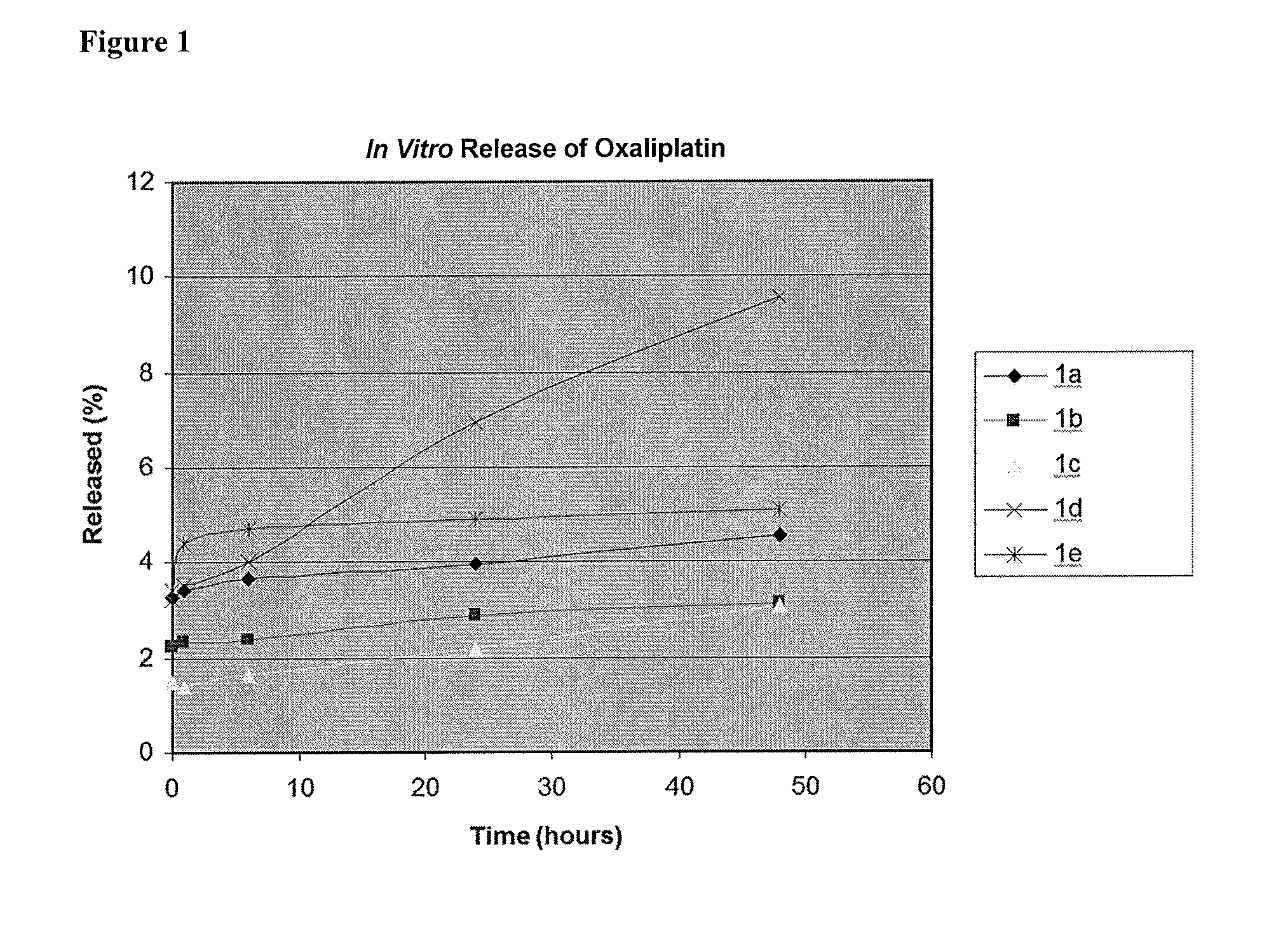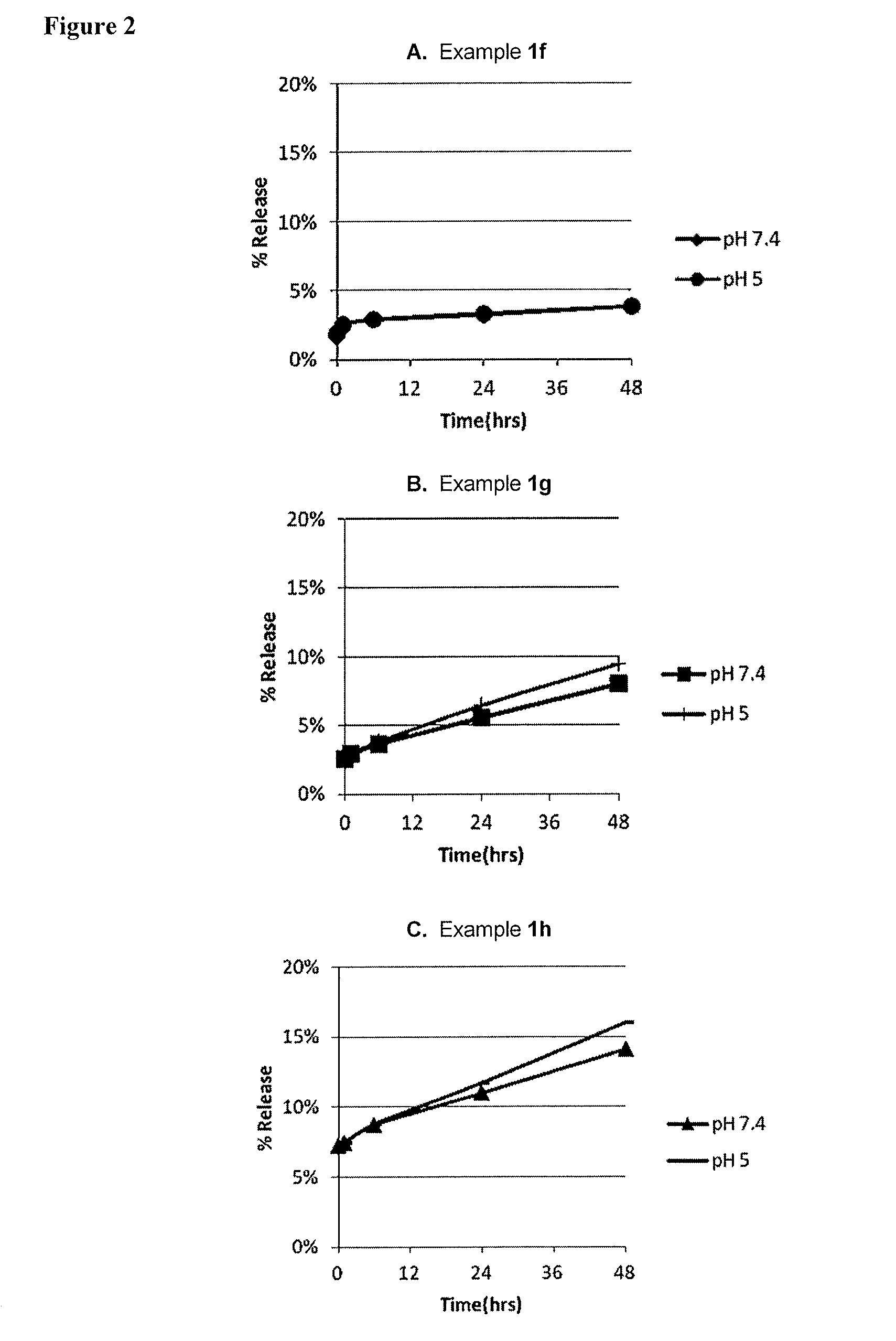Liposome oxaliplatin compositions for cancer therapy
a technology of liposome oxaliplatin and compositions, which is applied in the field of liposome oxaliplatin compositions for cancer therapy, can solve the problems of high-end hearing loss, toxicity of platins, kidney and nerve damage,
- Summary
- Abstract
- Description
- Claims
- Application Information
AI Technical Summary
Benefits of technology
Problems solved by technology
Method used
Image
Examples
example 2
In Vitro Release of Platin Drug from Liposomes
[0090]The in vitro release of oxaliplatin from liposomes in Examples 1a-1e (Table 2) was studied at pH 7.1. As shown in 1 / 11
FIG. 1, the release profiles indicated that POPC-based formulation 1d had the highest release rate in comparison to other formulations using saturated lipids. No significant difference was observed for the other four oxaliplatin formulations.
[0091]Examples 1f-1j, containing either cisplatin or oxaliplatin (Table 3), were compared with respect to platin release rate. In vitro release was determined at pH 5.0 and pH 7.1. As shown in Table 4, POPC-based formulations containing oxaliplatin (1i and 1j) exhibit pH-dependent release rates while other formulations containing cisplatin do not. Oxaliplatin formulations also exhibit faster and higher release than cisplatin formulations. Data in Table 4 are plotted in 2 / 11
FIG. 2 and FIG. 3.
[0092]Taking the release data for POPC-based formulations together, the release rates of ...
example 3
Physical Characterization of Liposomal Compositions
[0093]The phase transition temperature (Tm) of for the gel-to-fluid phase transition was determined for liposomes with varying lipid content, as shown in Table 5. A distinct phase transition temperature was detected for mixtures containing 55-95% saturated phosphatidyl choline (DPPC, DSPC, or HSPC), 0-40 mol % cholesterol, and 5 mol % DSPE-PEG. Tm values were in the range of about 41-56° C., much higher than ambient temperature or physiological temperature. In contrast, there was no detectable transition peak for the POPC-based formulation. The gel-liquid crystalline thermal transition temperature of POPC is around −2° C. Transition temperatures for binary mixtures of POPC and cholesterol have been reported to be much below 0° C.
TABLE 5Phase Transition Temperatures for Liposome FormulationsLiposome ComponentsMole RatioTm (° C.)DPPC / DSPE-PEGa95 / 543.1DPPC / Cholesterol / DSPE-PEG80 / 10 / 541.8DSPC / DSPE-PEG95 / 554.9HSPC / Cholesterol / DSPE-PEG57 / ...
example 4
Effects of Liposome Composition on Oxaliplatin Release Rate and Efficacy
Methods
[0097]Preparation of Oxaliplatin Formulation E000201-001.
[0098]Into a 20 mL scintillation vial was added 581 mg POPC (1-hexadecanoyl-2-(9Z-octadecenoyl)-sn-glycero-3-phosphocholine, Lipoid, FW=760, 0.76 mmol), 407 mg of cholesterol (Fisher, FW=386.7, 1.05 mmol) and 263 mg of DSPE-PEG(2000) (1,2-distearoyl-sn-glycero-3-phosphoethanolamine-N-[methoxy(polyethylene glycol)-2000], Lipoid, FW=2749, 0.10 mmol). This was dissolved into 2.5 mL EtOH (lipids dissolved in EtOH at 65° C. and at ambient temperature is a paste).
[0099]Into a 60 mL amber bottle was added 400 mg oxaliplatin (LC labs, 99% FW=397, 1 mmol) and 25 mL of aqueous 0.3 M sucrose solution. The oxaliplatin solution was heated to 65° C. in a temperature controlled water bath. To the heated solution was added the EtOH solution of lipids giving a milky white suspension. Heating continued at 65° C. for 30 min in the water bath.
[0100]The vesicles above w...
PUM
| Property | Measurement | Unit |
|---|---|---|
| Particle size | aaaaa | aaaaa |
| Particle size | aaaaa | aaaaa |
| Weight | aaaaa | aaaaa |
Abstract
Description
Claims
Application Information
 Login to View More
Login to View More - R&D
- Intellectual Property
- Life Sciences
- Materials
- Tech Scout
- Unparalleled Data Quality
- Higher Quality Content
- 60% Fewer Hallucinations
Browse by: Latest US Patents, China's latest patents, Technical Efficacy Thesaurus, Application Domain, Technology Topic, Popular Technical Reports.
© 2025 PatSnap. All rights reserved.Legal|Privacy policy|Modern Slavery Act Transparency Statement|Sitemap|About US| Contact US: help@patsnap.com



